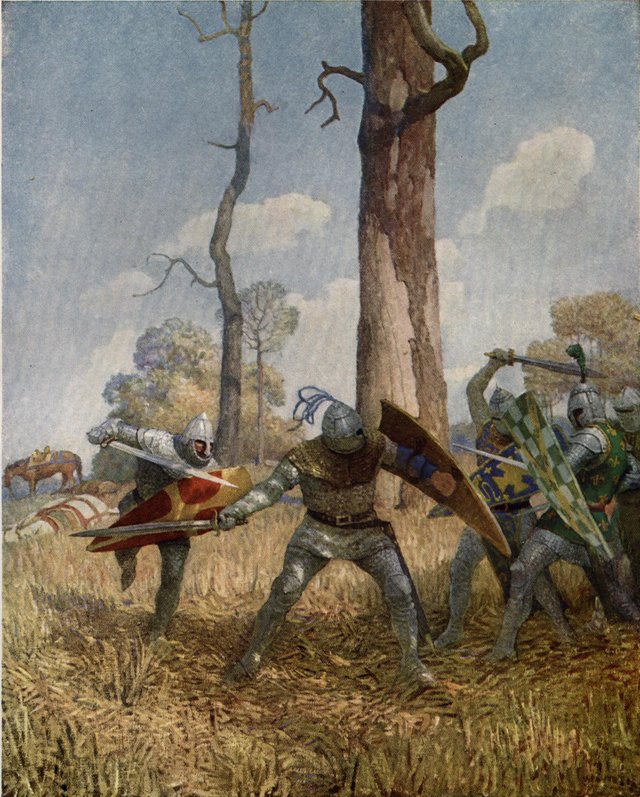My Original King Arthur String Quartet Movement 4: "The Battle" Inspired by the Art Work of N.C. Wyeth
Hello everyone! First of all, I'd like to say thank you for the support the last movement received. Thanks a lot to @ocd for the nomination! Acknowledgements aside, I am running out of time. I have tonight and tomorrow before I go off to band camp for a week, so I gotta bang out the last two movements at least. Tonight's movement is a Double Fugue (the meaning of that will be explained later on). First of all, let's get into the fantastic art work by N.C. Wyeth:
Art
Very much similar to the last movement, this painting comes many pages later, and there are many other pictures between the two movements' inspirations. The reason why I chose this one in particular, quite similarly to the last movement, is that this one is on display in the museum. On top of this, it is quite well done in my opinion. I would definitely say this is one of my favorites. Here it is:

Its caption reads:
"They fought with him on foot more than three hours, both before him and behind him"
Here is my interpretation:
Story
At this point in the story, Sir Tristam is talking to Sir Gareth and Sir Palamides about the death of a noble knight, Sir Lamorak, on King Arthur's orders. Sir Palamides recounts:
"Truly, I would have been there, and yet I never had a degree at no jousts there as he was, but he put me to the worse on foot or on horseback, and that day he was slain he did the most deeds of arms that ever I saw knight do all the days of my life. And when the degree was given him by my lord King Arthur, Sir Gawaine and his three brothers, Sir Agravaine, Sir Gaheris, and Sir Mordred, set upon Sir Lamorak in a privy place, and there they slew his horse, and so they fought with him on foot more than three hours, both before him and behind him. And Sir Mordred gave him his death wound behind him at his back, and all to-hewed him; for one of his squires told me that saw it."
So, as you can see, Sir Palamides, is telling Sir Tristam what unfolded and how an honorable knight wound up killed dishonorably. This painting depicts the knights in the flashback fighting, and, if you look closely, you can see Sir Lamorak's slain horse. I can't imagine having to fight, in a suit of metal armor, four knights on foot for more than three hours. Man, he lasted a lot longer than I would have. After about 10 minutes, I'd have asked them to stab me. Anyway, let's get into the music.
Music
Ok, so this is probably the most demanding idea I've ever tried to develop. I've written single fugues, but never a Double fugue. For those of you who don't know what a double fugue is, a double fugue is a fugue with two subjects instead of one. In this case, I chose to have the two subjects enter simultaneously, but sometimes composers will have two expositions, develop the material together then combine the two subjects at the end.
I decided to utilize a double fugue because I thought it would accurately depict the chaos of a battle. Why double? I thought the concept of two fighting parties and 2 "feuding" subjects had a satisfying allurement.
There is actually precedent for using a fugue in a battle scene in one of Verdi's operas, though I did not listen to this, or draw influence from it. For this movement, I drew influence from the Kyrie of Mozart's Requiem (also a double fugue):
I actually used the Kyrie and Christe texts in creating the two subjects, though it obviously isn't evidenced in the final product.
Imagery/Stuff going on
Within the piece, I obviously have the two subjects which I earlier talked about almost representing two fighting parties. Within this movement, I also utilized the Arthur theme (since Arthur is the overbearing force on who's orders caused this battle), and tried to depict the exhaustion (I'd imagine these men would be feeling after three hours) in the end (through augmentation of the themes). In the end, I also combined the three themes (two subjects and Arthur theme). The final cadence slows down dramatically (After pausing on a vii°6/5/V)(very much like the Mozart Kyrie which pauses after a vii°7/V). I then slowed down the final cadence (which highlights a chromatic descent in the bass from D natural to D-flat to C) in order to depict the inhaling and exhaling which one would hear at the end of the battle (as described in the music).
Kyrie Text
I also like the imagery behind drawing from a Kyrie for this. The text translates to:
Kyrie Eleison -> Lord have mercy
Christe Eleison -> Christ have mercy
I feel like this is a good feeling for this scene because Arthur seems to be in the wrong here, and his men seem to be doing something quite dishonorable on his orders. This demonstrates that even Arthur can make poor decisions resulting in sin.
Ending on A Unison
Lastly, I would like to discuss ending on a unison. I did this (1) for a surprise, and (2) in order to ease the transition to the last movement (in e minor which will be further developed by emphasizing the neapolitan sixth in the final movement).
Conclusion
Thanks for reading/listening to this! I hope you enjoyed hearing this movement as much as I enjoyed writing it. This was a much needed challenge for me as a learning composer, and I look forward to hearing it on real instruments. I apologize for the utter disgust of the computer's tremolos in the end. Please remember that, as always, feedback is very much appreciated. I look forward to developing my contrapuntal writing in the coming years, and, I again hope you enjoyed this work. Have a nice night! Hopefully I will see you tomorrow for The Death of Arthur!

(Note) In order to encourage meaningful feedback on the platform, I will check comment trails of users who leave superficial comments (ie "Awesome post," or "Upvoted.") and will mute any users who exhibit a pattern of leaving "spammy" comments.
Resteemed, your post will appear in the next curation with a SBD share for you!
Your post has been supported and upvoted from the Classical Music community on Steemit as it appears to be of interest to our community. We also support jazz and folk music posts!
If you enjoy our support of the #classical-music community, please consider a small upvote to help grow the support account!
You can find details about us below.
The classical music community at #classical-music and Discord. Follow our community accounts @classical-music and @classical-radio or follow our curation trail (classical-radio) at SteemAuto!
Delegation links: 10SP, 25SP, 50SP, 75SP, 100SP, 150SP, 200SP, 250SP, 500SP, 1000SP
This post was shared in the Curation Collective Discord community for curators, and upvoted and resteemed by the @c-squared community account after manual review.
@c-squared runs a community witness. Please consider using one of your witness votes on us here